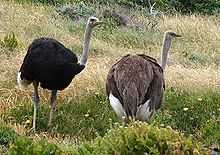Struthio
| Struthio Temporal range: Miocene-Holocene, 23–0Ma | |
|---|---|
 | |
| Common ostrich (Struthio camelus), male and female | |
| Scientific classification | |
| Kingdom: | Animalia |
| Phylum: | Chordata |
| Class: | Aves |
| Order: | Struthioniformes |
| Family: | Struthionidae |
| Genus: | Struthio Linnaeus, 1758[1] |
| Type species | |
| Struthio camelus Linnaeus, 1758 | |
| Species | |
|
†Struthio coppensi | |
Struthio is a genus of bird in the order Struthioniformes.
Species
There are ten known species from this genus, of which eight are extinct. There are five more possible species of which trace fossils have been found. They are:
- †Struthio coppensi (Early Miocene of Elizabethfeld, Namibia)
- †Struthio linxiaensis (Liushu Late Miocene of Yangwapuzijifang, China)
- †Struthio orlovi (Late Miocene of Moldavia)
- †Struthio karingarabensis (Late Miocene - Early Pliocene of SW and CE Africa) - oospecies(?)
- †Struthio kakesiensis (Laetolil Early Pliocene of Laetoli, Tanzania) - oospecies
- †Struthio wimani (Early Pliocene of China and Mongolia)
- †Struthio daberasensis (Early - Middle Pliocene of Namibia) - oospecies
- †Struthio brachydactylus (Pliocene of Ukraine)
- †Struthio chersonensis (Pliocene of SE Europe to WC Asia) - oospecies
- †Struthio asiaticus, Asian ostrich (Early Pliocene - Late Pleistocene of Central Asia to China ?and Morocco)
- †Struthio dmanisensis, giant ostrich (Late Pliocene/Early Pleistocene of Dmanisi, Georgia)
- †Struthio oldawayi (Early Pleistocene of Tanzania) - probably subspecies of S. camelus
- †Struthio anderssoni - in N China/Mongolia[2] oospecies(?)
- Struthio camelus, common ostrich
- Struthio molybdophanes, Somali ostrich
Fossil records and egg shell fragments show that the ancestors of this genus originated about 40-58 million years ago (mya) in the Asiatic steppes as small flightless birds. The earliest fossils from this genus are from the early Miocene (20-25mya), and are from Africa, so it is proposed that they originated there. Then by the middle to late Miocene (5-13mya) they had spread to Eurasia.[3] By about 12 mya they had evolved into the larger size of which we are familiar. By this time they had spread to Mongolia and, later, South Africa.[4]
Evolution
The genus Struthio used to include the Emu, Rhea, and also the Cassowary, until they each were placed in their own genera.[1] The Somali ostrich, Struthio molybdophanes, has recently become recognized as a separate species by some authorities, while others are still reviewing the information.[5][6]
Footnotes
- ↑ 1.0 1.1 Gray, G.R. (1855)
- ↑ Lisa Janz et al, Dating North Asian surface assemblages with ostrich eggshell: implications for palaeoecology and extirpation. Journal of Archaeological Science, Volume 36, Issue 9, September 2009, Pages 1982–1989; also J. G. Andersson, Essays on the cenozoic of northern China. In: Memoirs of the Geological Survey of China (Peking), Series A, No. 3 (1923), pp. 1-152, especially pp. 53-77: "On the occurrence of fossil remains of Struthionidae in China."; and J. G. Andersson, Research into the prehistory of the Chinese. Bulletin of the Museum of Far Eastern Antiquities 15 (1943), 1-300, plus 200 plates.
- ↑ Hou, L. et al. (2005)
- ↑ Davies, S.J.J.F. (2003)
- ↑ Gil, F. & Donsker D. (2012)
- ↑ Birdlife International (2012)
References
- BirdLife International (2012). "The BirdLife checklist of the birds of the world, with conservation status and taxonomic sources." (XLS). Retrieved 16 Jun 2012.
- Brands, Sheila (14 Aug 2008). "Taxon: Genus Struthio". Project: The Taxonomicon. Retrieved 12 Jun 2012.
- Davies, S. J. J. F. (2003). "Ostriches". In Hutchins, Michael. Birds I Tinamous and Ratites to Hoatzins. Grzimek's Animal Life Encyclopedia 8 (2nd ed.). Farmington Hills, MI: Gale Group. p. 99. ISBN 0-7876-5784-0.
- Gill, F.; Donsker, D (2012). "Ratites". IOC World Bird List. WorldBirdNames.org. Retrieved 13 Jun 2012.
- Gray, George Robert (1855). Catalogue of the Genera and Subgenera of Birds contained in the British Museum. London, UK: Taylor and Francis. p. 109.
- Hou, L.; Zhou, Z.; Zhang, F.; Wang, Z. (Aug 2005). "A Miocene ostrich fossil from Gansu Province, northwest China". Chinese Science Bulletin 50 (16): 1808–1810. doi:10.1360/982005-575. ISSN 1861-9541.
- Janz, Lisa, et al. Dating North Asian surface assemblages with ostrich eggshell: Implications for palaeoecology and extirpation. Journal of Archaeological Science, Volume 36, Issue 9, September 2009, Pages 1982–1989. http://dx.doi.org/10.1016/j.jas.2009.05.012